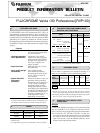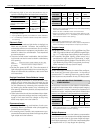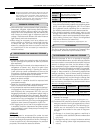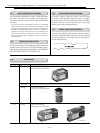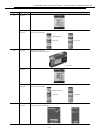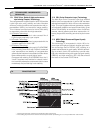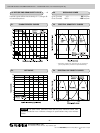
– 3 –
FUJICHROME Velvia 100 Professional
[
RVP100
]
• FUJIFILM PRODUCT INFORMATION BULLETIN
NOTE Exposure correction values given above for long and
multiple exposures are for a reversal film with an aver-
age emulsion when processed under standard pro-
cessing conditions. Therefore, use the data only as a
guide. For exacting work, test exposures are recom-
mended under actual shooting conditions.
7. EXPOSURE PRECAUTIONS
•With artificial light, such as electronic flash, photoflood,
fluorescent, tungsten, high intensity discharge lamp
(metal halide, sodium, mercury vapor), etc., the lamp
output and color temperature may be affected by
such factors as brand, age of equipment and line
voltage. Reflectors and diffusers can also influence
light intensity and color temperature.
• When using an accessory such as a reflector um-
brella, reflector or diffuser to control light intensity
or diffuse the light, the color of the light may be
altered by changes that have occurred in the color
or composition of the accessory’s materials or
reflective surface.
8. UNPROCESSED FILM HANDLING /STORAGE
HANDLING
• Expose film before the expiration date indicated on
the film package and process as soon as possible
after exposure.
• When removing film stored at low temperatures (in a
refrigerator or freezer, etc.), allow it to reach room
temperature before opening it. Opening film while it
is still cold may cause condensation to form on the
film surface, causing color changes or the emulsion
to become more susceptible to scratches.
• Roll film should be loaded and unloaded quickly and
away from direct sunlight.
• Film loaded in cameras should be exposed and
processed promptly.
• Sheet film must be handled in total darkness and with
care so as not to touch the emulsion surface.
• X-rays inspection machines used to inspect checked-
in baggage at airports can cause fogging of film. Put
both exposed and unexposed film into carry-on
baggage (preferably in a transparent plastic bag or
a net bag that allows the film to be seen). Because of
the increasing number of airports using strong X-ray
machines for carry-on baggage, it is recommended
that you remove film from your carry-on baggage and
request a visual (manual) inspection of your film.
• Film fogging may occur near X-ray equipment used
in hospitals, factories, laboratories and other places
where radiation is used. Always keep film away from
sources of radiation.
STORAGE
Storing exposed or unexposed film under hot and
humid conditions may adversely affect the speed, color
balance and physical properties of the film. Although it
is best to store film at a low temperature, for practical
purposes, film should be stored as follows:
Store at a place (cool and dark)
away from direct sunlight or high
temperatures and humidity.
Store at 10°C (50°F) or below
Short-term
Storage
Long-term
Storage
• New building materials, newly manufactured furni-
ture, paints and bonding agents may produce gases
which could affect photographic film. Do not store
film, lightproof boxes containing film or cameras or
film holders loaded with film near these materials.
• Film should be sealed in plastic bags* prior to cold
storage. When taken out of cold storage, film should
be allowed to reach room temperature before open-
ing by letting it stand over 3 hours (for refrigerated
film) or over 6 hours (for frozen film).
* Polyester, polystyrene, polyethylene, polypropylene, etc.
9. PROCESSING
This film is designed for processing by Process E-6 or
its equivalent, as well as Fujifilm Process CR-56.
10. PROCESSED FILM HANDLING / STORAGE
Since the purpose of film is to provide a long-term
record of memorable events, as much effort as possible
has been made to use materials that exhibit the least
amount of change over time, but the effects of light,
heat, atmospheric oxygen, contaminant gases, humidity
and mold cannot be completely avoided. It is possible,
however, to minimize change in the photographic
image or base material by maintaining appropriate
storage conditions, such as those used by museums
and art galleries. Temperature and humidity control is
the most important key to minimizing the change that
occurs in film. Processed film stored in the dark un-
der the following conditions may be expected to show
almost no change over time.
Storage Period with
Temperature Relative Humidity
Almost No Change
More than 20 years Below 10°C30%–50%
10–20 years Below 25°C30%–50%
(1) Color reversal film should be mounted inserted into
sleeves* for storage.
* Polyester, polystyrene, polyethylene, polypropylene, etc.
(2) Processed film should be stored at a place as far
away as possible from high temperatures, direct
sunlight and other strong light. The following con-
ditions are not desirable for the storage of film
and should be avoided in the case of long-term
storage:
• Storage in a closet lying against a wall that is
exposed to cold, outside air (where condensation
may form).
• Storage in an attic or on top of a closet or cabinet
near the ceiling (where high temperatures may
occur).



